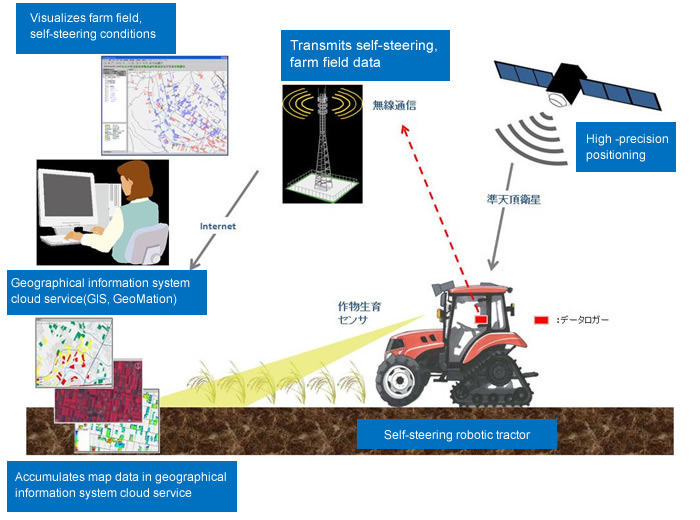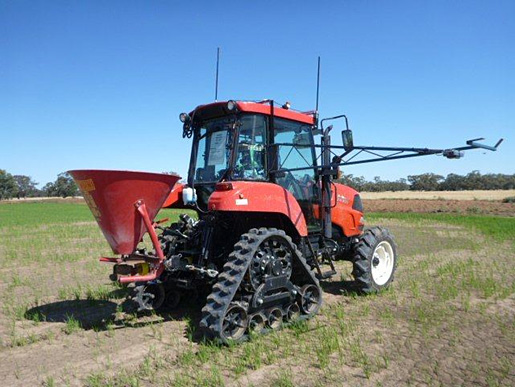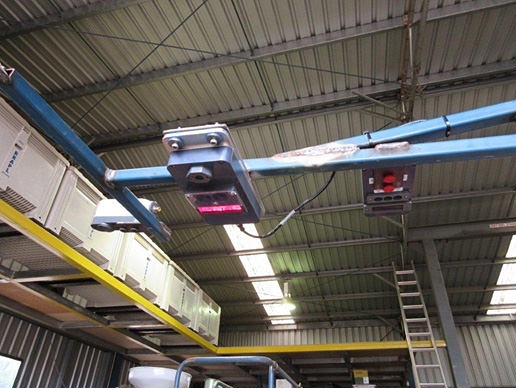Information
Yanmar Conducts Feasibility Study on Using Quasi-Zenith Satellite System for Precision Farming
February 4, 2015
Yanmar Co., Ltd.
Hitachi Zosen Corporation, Hitachi, Ltd., and Yanmar Co., Ltd., have been commissioned to conduct a study on the effective use overseas of advanced positioning signals from Japan’s Quasi-Zenith Satellite System (QZSS) (*1), organized by the Ministry of Internal Affairs and Communications of Japan.
The study seeks to verify that advanced positioning signals transmitted from the QZSS can be used in precision farming in Australia. Specifically, demonstration tests will be conducted using the advanced positioning signals to control a self-steering robotic tractor and perform actual farm work in a paddy field. At present, technical validation is in progress for three high-precision positioning methods: 1) RTNet, 2) RMIT, and 3) MADOCA (*2). The demonstration tests aim to determine the optimal positioning method for precision farming in Australia.
The mainstream positioning method, precise point positioning (PPP), receives positioning data directly from GPS satellites. The challenge is that this provides limited accuracy with an error of approximately 10–20 centimeters, and cannot be replaced with data of centimeter-level accuracy. The study aims to enhance positioning accuracy by employing a new method, precise point positioning with ambiguity resolution (PPP-AR), using Australia’s electronic datum points (* 3), and make it possible to perform accurate farm work with an error of 5 centimeters. The first demonstration test, conducted in late November 2014 during the growth stage of rice, succeeded in controlling the self-steering robotic tractor so that its tires run between rows of planted rice. In January 2015, the tractor will be used to monitor growth conditions. The study will continue thereafter, performing several aspects of farm work at different timings.
Following the study, farm workers and government officials will be interviewed based on the demonstration test results to identify challenges in commercializing precision farming employing advanced positioning signals. In the future, a consortium is scheduled to be organized centering on the three commissioned companies to actively promote precision farming. Plans include further enhancing the accuracy of positioning data, applying the technology to other programs, and expanding services to regions other than Australia, such as Japan and Asia.
【Study Abstract】
1. Consignor :
Ministry of Internal Affairs and Communications
2. Title :
“Study on the Effective Use Overseas of Advanced Positioning Signals from Japan’s Quasi-Zenith Satellite System”
3. Details :
Generate highly accurate positioning correction data from QZSS’s LEX signal (*4) and collect data on field and rice growth conditions using a self-steering tractor.
4. Commissioned companies :
Hitachi-Zosen, Hitachi and Yanmar, as core members.
Japan Aerospace Exploration Agency (JAXA), who operates QZSS, and various research institutes in Japan and Australia for technical cooperation and research support.
5. Roles of organizations involved :
- Hitachi-Zosen (main contractor) - Supervises whole project. Investigates feasibility of study, evaluates positioning data accuracy and overall project development. Uses PPP-AR positioning function of Hitachi-Zosen’s multi-GNSS analytic software “RTNet” as a new positioning method to generate highly accurate positioning correction data which is able to superimpose on QZSS’s LEX signal, and verifies position accuracy and operability in the field of a self-steering robotic tractor.
- Hitachi - Tracks and integrates data of a self-steering robotic tractor and crop growth sensors installed on it into “GIS Cloud Service” (*5) and displays machine operation and crop growth conditions on computer maps. This will verify tractor path and movement precision, and enhance farm planning and operations precision.
- Yanmar - Develops, manages and operates a self-steering robotic tractor.
- Hitachi Australia Pty Ltd - Conducts project management and workshops, and coordinates with the related research institutes in Australia.
- Hokkaido University - Supports precision farming research (agricultural information engineering research).
- Japan Aerospace Exploration Agency (JAXA) -Operates QZSS (generation and distribution conversion of correction data, technical support).
- Cooperative Research Centre for Spatial Information (CRC-SI) - Supports geospatial information research and investigation.
- Royal Melbourne Institute of Technology (RMIT) University - Supports positioning system research (satellite positioning research and investigation).
- University of New South Wales (UNSW) Australia - Supports positioning system research (satellite positioning research and investigation).
- University of New England (UNE) - Supports precision farming research (precision farming research).
- Rice Research Australia Pty Ltd (RRA) - Supports precision farming research (agricultural research on rice).
- SmartNet AUS - Provides data from Australia-based electronic datum points.
6. Area : New South Wales, Australia
7. Period : October, 2014 - March, 2015
【Reference Data】



Crop Circle TM is a registered trademark of Holland Scientific Inc.
【Terminology】
(*1) Quasi-Zenith Satellite System (QZSS)
- Satellite-based positioning system for use in Japan, Asia and Oceania
- The first satellite, “Michibiki”, was launched on September 11, 2010.
- Three additional satellites are planned for launch in the interval 2016-2017, and from 2018, the system is scheduled to operate using four satellites.
- Unimpeded satellite signal allows for continuous reception in Japan.
- Allows highly accurate signal transmission similar to the US-government operated Global Positioning System (GPS), and the proprietary LEX signal permits transmission of high precision positioning data.
- LEX signal facilitates high precision measurements, traffic navigation, assistance to self-steering vehicles, precision farming etc.
(*2) Three high-precision positioning methods
A number of organizations provide positioning methods for utilizing advanced data from the QZSS, each method with different characteristics. The study covers both precise point positioning (PPP), which receives positioning data directly from satellites, and precise point positioning with ambiguity resolution (PPP-AR), which augments the data using electronic datum points, to determine the optimal method from the three given below.
- RTNet
[Characteristics]
- RTNet is a PPP method, as it does not require electronic datum points for high-precision positioning; however, it is also a PPP-AR method, as it uses correction data from regional electronic datum points to achieve centimeter-level accuracy.
- RTNet enables centimeter-level positioning within an approximately 1,500-kilometer area of the electronic datum point network.
- Validation is in progress to obtain correction data globally using electronic datum points worldwide.
- RMIT
[Characteristics]
- Like RTNet, RMIT is a PPP method that does not require electronic datum points for high-precision positioning.
- RMIT is compatible with PPP-AR.
- RMIT obtains codrrection data using electronic datum points Worldwide provided by the International GNSS Service (IGS) and by the JAXA-operated Multi GNSS Monitoring Network (MGM-Net).
- MADOCA
[Characteristics]
- Like RTNet, MADOCA is a PPP method that does not require electronic datum points for high-precision positioning.
- MADOCA is compatible only with PPP; compatibility with PPP-AR is under development.
- MADOCA obtains correction data using electronic datum points worldwide provided by the International GNSS Service (IGS) and by the JAXA-operated Multi GNSS Monitoring Network (MGM-Net).
(*3)Electronic datum point
- Electronic datum points consist of an antenna, GNSS receiver, and transmitter on the Earth’s surface. They are used as a benchmark for positioning and geodetic surveying.
- Traditional benchmarks consist of a stone pillar with engraved markings; however, since electronic datum points are designed to work with satellites, the benchmark is the phase center of the aforementioned antenna. Each electronic datum point receives signals from satellites around the clock, digitally processes the data, and transmits the data to a central monitoring station.
- The central monitoring station generates and transmits satellite and atmospheric correction data based on information collected from all electronic datum points.
The correction data transmitted is then used to calculate positioning and perform accurate monitoring and geodetic surveying.
(*4)LEX (L-band experiment) signal
- Trial signal employed on “Michibiki”, the first satellite launched in 2010 (See section 1 above for details!) for enhanced positioning technology and improved GPS precision and reliability.
- LEX signal tracks location to the centimeter.
Planned to be renamed L6 upon official introduction.
(*5) GIS Cloud Service
- A cloud service Hitachi Solutions, Ltd. provides. It is a one-stop service with GIS operation, which supplies map data contents (e-maps, aerial photographs, satellite images, etc ), servers and OS for cloud platform and API for GIS, including GIS engine “GeoMation” to visualize various kinds of data on the computer maps.
- Saves the initial, operation and maintenance cost by using cloud system.
**”GeoMation” is a registered trademark of Hitachi Solutions, Ltd. in Japan.
Inquiries:
Public Relations Group
General Affairs Dept., Yanmar Co., Ltd.
TEL: +81-6-6376-6212
FAX: +81-6-6372-2455
E-mail: koho@yanmar.co.jp










